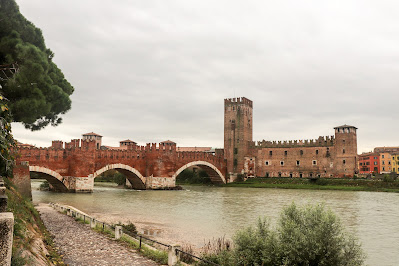 |
| Roman Arena in Piazza Bra |
Our day began in Piazza Bra, the central square of Verona, which used to be the arrival space before the Roman Gates. Verona became an important Roman town in the 2nd century BC because it was at the junction of three Roman roads. The Roman Arena was built in 30 AD, 50 years older than the Coliseum in Rome. In the summer it is home to the Verona Opera Festival. The outer ring was destroyed in 1117 by an earthquake.
 |
| Interior of Arena |
The city became prosperous during the Reign of the della Scalla family during the 13th and 14th centuries. We walked to the Market Square to see the Palazzo Maffei and the Gardello tower on one side and the City Hall with the Lamberti Tower on the other. We continued to the 13th century Santa Anastasia church. Behind the church was the Adige River. This used to provide power to many mills, but in 1882 a flood destroyed the mills. The town built the walls we see today and channeled some of the river into a canal to reduce the risk of flooding. Nearby were the della Scalla family sarcophagi underneath stone arches. This is the location of Juliet’s staged death in Romeo and Juliet. Next was the Piazza dei Signori. The Portico of the Councel is a Venetian Renaissance Building. In the courtyard is a Statue of Dante, father of the Italian language and author of the “Divine Comedy”. We finished our morning at the House of Juliet.
 |
| House of Juliet |
While the house is authentic, the balcony was built in 1937. In the afternoon we walked to the Castelvechio, the old castle, built in 1356 to protect the Scalla family and allow him to escape on his private bridge. The protective wall wouldn’t protect from cannonballs in the 15th century, but by then the town walls were built.
 |
| Castelvechio and its bridge |

No comments:
Post a Comment